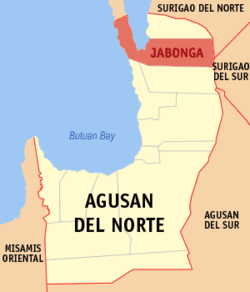Jabonga
Jabonga | |
|---|---|
 Location within Agusan del Norte province | |
| Country | Philippines |
| Region | Caraga |
| Province | Agusan del Norte |
| District | 2nd district of Agusan del Norte |
| Barangays | 15 (see Barangays) |
| Government | |
| • Type | Sangguniang Bayan |
| • Mayor | Jasmin Flores Monton |
| Area | |
| • Total | 293 km2 (113 sq mi) |
| Population (2020 census)[3] | |
| • Total | 24,855 |
| • Density | 85/km2 (220/sq mi) |
| • Voter (2022)[4] | 17,083 |
| Time zone | UTC+8 (PST) |
| ZIP code | 8607 |
| IDD : area code | +63 (0)85 |
| Income class | 3rd class |
| PSGC | 160205000 |
| Website | www |
Jabonga, officially the Municipality of Jabonga (Filipino: Bayan ng Jabonga), is a municipality in the province of Agusan del Norte in the Caraga of the Philippines. The population was 24,855 at the 2020 census.[3] Template:PH electorate
History
Jabonga traces its origin to a village formerly occupied by Negritoes and a few Christian immigrants led by a Manobo Negrito meztizo Angelecio Montante, also called Agaras. The village became known as Celopan, a name derived from the bamboos growing along the bank of the river that were made into smoking pipes.
Sometime during the mid-nineteenth century, the increasing number of inhabitants who were joined by Christian immigrants from other places transferred to a new settlement in the present site of Colorado[clarification needed]. By this time, The Spanish government was already sending missionaries to all parts of the island and the group that went up the Kalinawan River reached the settlement of Colorado, a name derived from the word Colorado meaning colored, because of the white spotted arms of Domingo Mondoy, the brave settler who dared to face the newcomers. Proceeding upstream, the missionaries reached Celopan and seeing a native inside a hut, the floor of which was just one meter above the water, they asked him what the place was called. Thinking that the Spaniards were referring to the hut, he answered Habongan. Thus, Celopan was renamed Habongan which later became Jabonga.
Geography
Jabonga is located at 9°20′35″N 125°30′56″E / 9.34306°N 125.51556°E.
According to the Philippine Statistics Authority, the municipality has a land area of 293 square kilometres (113 sq mi)[2] constituting 10.73% of the 2,730.24-square-kilometre- (1,054.15 sq mi) total area of Agusan del Norte.
Jabonga is bounded by Kitcharao and Surigao del Norte to the north; Butuan Bay to the west; Tubay and Santiago to the south; Surigao del Sur to the east. It is 60 kilometres (37 mi) from Butuan City.
The topography of the land features plain to rolling and hills. Among the municipalities, Jabonga ranks first in total area and number of farms (464) mostly owned by individuals. It has one of the 36 crop storage facilities of the province. Its major crops are coconut, rice, corn, timber and both fresh and sea-water fish.
Barangays
Jabonga is politically subdivided into 15 barangays.[5]
| PSGC | Barangay | Population | ±% p.a. | |||
|---|---|---|---|---|---|---|
| 2020[3] | 2010[6] | |||||
| 160205003 | A. Beltran (Camalig) | 4.4% | 1,083 | 1,149 | −0.59% | |
| 160205001 | Baleguian | 9.0% | 2,232 | 2,136 | 0.44% | |
| 160205002 | Bangonay | 12.6% | 3,122 | 3,073 | 0.16% | |
| 160205004 | Bunga | 2.6% | 638 | 951 | −3.91% | |
| 160205005 | Colorado | 6.8% | 1,683 | 1,570 | 0.70% | |
| 160205006 | Cuyago | 7.6% | 1,883 | 2,015 | −0.68% | |
| 160205007 | Libas | 5.6% | 1,384 | 1,455 | −0.50% | |
| 160205008 | Magdagooc | 6.0% | 1,482 | 1,464 | 0.12% | |
| 160205009 | Magsaysay | 4.1% | 1,031 | 1,155 | −1.13% | |
| 160205010 | Maraiging | 2.1% | 518 | 507 | 0.21% | |
| 160205011 | Poblacion (Jabonga) | 15.4% | 3,822 | 3,713 | 0.29% | |
| 160205012 | San Jose | 3.2% | 784 | 977 | −2.18% | |
| 160205013 | San Pablo | 4.6% | 1,136 | 957 | 1.73% | |
| 160205014 | San Vicente | 6.2% | 1,534 | 1,747 | −1.29% | |
| 160205015 | Santo Niño | 3.4% | 852 | 964 | −1.23% | |
| Total | 24,855 | 23,833 | 0.42% | |||
Demographics
|
| ||||||||||||||||||||||||
| Source: PSA[7][6][8] | |||||||||||||||||||||||||
In the 2020 census, Jabonga had a population of 24,855.[3] The population density was 85 inhabitants per square kilometre (220/sq mi)*.
References
- ^ Municipality of Jabonga | (DILG)
- ^ a b "Province: Agusan del Norte". PSGC Interactive. Makati City, Philippines: Philippine Statistics Authority. Retrieved 28 October 2016.
- ^ a b c d Census of Population (2020). "Caraga". Total Population by Province, City, Municipality and Barangay. Philippine Statistics Authority. Retrieved 8 July 2021.
- ^ "Number of Registered Voters by Sex : 2019 National and Local Elections" (PDF). Commission on Elections. 2019.
- ^ "Municipal: Jabonga". PSGC Interactive. Quezon City, Philippines: Philippine Statistics Authority. Retrieved 8 January 2016.
- ^ a b Census of Population and Housing (2010). "Caraga" (PDF). Total Population by Province, City, Municipality and Barangay. National Statistics Office. Retrieved 29 June 2016.
- ^ Census of Population (2015). "Caraga". Total Population by Province, City, Municipality and Barangay. Philippine Statistics Authority. Retrieved 20 June 2016.
- ^ Censuses of Population (1903–2007). "Caraga". Table 1. Population Enumerated in Various Censuses by Province/Highly Urbanized City: 1903 to 2007. National Statistics Office.

